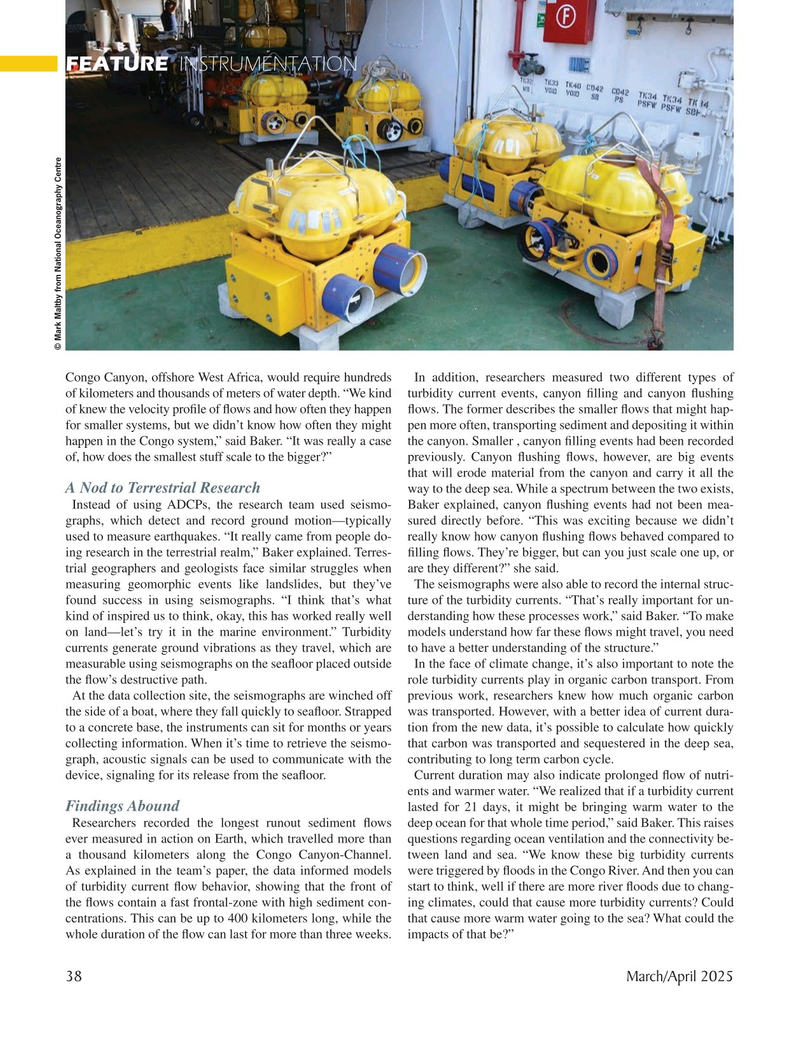
Page 38: of Marine Technology Magazine (March 2025)
Read this page in Pdf, Flash or Html5 edition of March 2025 Marine Technology Magazine
FEATURE INSTRUMENTATION © Mark Maltby from National Oceanography Centre
Congo Canyon, offshore West Africa, would require hundreds In addition, researchers measured two different types of of kilometers and thousands of meters of water depth. “We kind turbidity current events, canyon ? lling and canyon ? ushing of knew the velocity pro? le of ? ows and how often they happen ? ows. The former describes the smaller ? ows that might hap- for smaller systems, but we didn’t know how often they might pen more often, transporting sediment and depositing it within happen in the Congo system,” said Baker. “It was really a case the canyon. Smaller , canyon ? lling events had been recorded of, how does the smallest stuff scale to the bigger?” previously. Canyon ? ushing ? ows, however, are big events that will erode material from the canyon and carry it all the
A Nod to Terrestrial Research way to the deep sea. While a spectrum between the two exists,
Instead of using ADCPs, the research team used seismo- Baker explained, canyon ? ushing events had not been mea- graphs, which detect and record ground motion—typically sured directly before. “This was exciting because we didn’t used to measure earthquakes. “It really came from people do- really know how canyon ? ushing ? ows behaved compared to ing research in the terrestrial realm,” Baker explained. Terres- ? lling ? ows. They’re bigger, but can you just scale one up, or trial geographers and geologists face similar struggles when are they different?” she said. measuring geomorphic events like landslides, but they’ve The seismographs were also able to record the internal struc- found success in using seismographs. “I think that’s what ture of the turbidity currents. “That’s really important for un- kind of inspired us to think, okay, this has worked really well derstanding how these processes work,” said Baker. “To make on land—let’s try it in the marine environment.” Turbidity models understand how far these ? ows might travel, you need currents generate ground vibrations as they travel, which are to have a better understanding of the structure.” measurable using seismographs on the sea? oor placed outside In the face of climate change, it’s also important to note the the ? ow’s destructive path. role turbidity currents play in organic carbon transport. From
At the data collection site, the seismographs are winched off previous work, researchers knew how much organic carbon the side of a boat, where they fall quickly to sea? oor. Strapped was transported. However, with a better idea of current dura- to a concrete base, the instruments can sit for months or years tion from the new data, it’s possible to calculate how quickly collecting information. When it’s time to retrieve the seismo- that carbon was transported and sequestered in the deep sea, graph, acoustic signals can be used to communicate with the contributing to long term carbon cycle. device, signaling for its release from the sea? oor. Current duration may also indicate prolonged ? ow of nutri- ents and warmer water. “We realized that if a turbidity current
Findings Abound lasted for 21 days, it might be bringing warm water to the
Researchers recorded the longest runout sediment ? ows deep ocean for that whole time period,” said Baker. This raises ever measured in action on Earth, which travelled more than questions regarding ocean ventilation and the connectivity be- a thousand kilometers along the Congo Canyon-Channel. tween land and sea. “We know these big turbidity currents
As explained in the team’s paper, the data informed models were triggered by ? oods in the Congo River. And then you can of turbidity current ? ow behavior, showing that the front of start to think, well if there are more river ? oods due to chang- the ? ows contain a fast frontal-zone with high sediment con- ing climates, could that cause more turbidity currents? Could centrations. This can be up to 400 kilometers long, while the that cause more warm water going to the sea? What could the whole duration of the ? ow can last for more than three weeks. impacts of that be?” 38 March/April 2025
MTR #3 (34-49).indd 38 3/13/2025 11:48:19 AM

 37
37

 39
39
